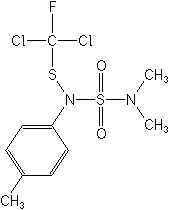-
Common NameTolylfluanid
-
中文通用名甲苯氟磺胺
-
IUPACN-dichlorofluoromethylthio-N′,N′-dimethyl-N-p-tolylsulfamide
-
CAS1,1-dichloro-N-[(dimethylamino)sulfonyl]-1-fluoro-N-(4-methylphenyl)methanesulfenamide
-
CAS No.731-27-1
-
Molecular FormulaC10H13Cl2FN2O2S2
-
Molecular Structure
-
Category
-
ActivityFungicide
-
PremixWettable powder, water dispersible granule. Premix Parters: chinomethionat; copper oxychloride propineb; cymoxanil propineb; metalaxyl; propineb; tebuconazole; trifloxystrobin;
-
Physical PropertiesMolecular weight:347.3; Physical form:Colourless, odourless, crystalline powder. Density:1.52 g/cm3 (20 °C); Melting point:93 °C; Vapour pressure:0.2 mPa (20 °C); Henry constant:7.7 × 10-2 Pa m3 mol-1 ( calc.); Partition coefficient(n-octanol and water):logP = 3.90 (20 °C); Solubility:In water 0.9 mg/l (20 °C). In heptane 54, dichloromethane >250, isopropanol 22, xylene 190 (all in g/l, 20 °C).; Stability:Hydrolysis DT50 (22 °C) 12 d ( pH 4), 29 h (pH 7), <10 min ( pH 9). Under environmental conditions, hydrolysis occurs much more rapidly than photolysis.;
-
ToxicologyOral:Acute oral LD50 for rats >5000, mice >1000, guinea pigs 250-500 mg/kg. Percutaneous:Acute percutaneous LD50 for rats >5000 mg/kg. Severely irritating to skin and moderately irritating to eyes (rabbits). Skin sensitiser. Inhalation: LC50 (4 h) for rats c. 0.265 mg/l air (aerosol).
-
Environmental ProfileEcotoxicology:
Algae: ErC50 for Scenedesmus subspicatus >1.0 mg/l.Bees:Non-toxic to bees.Birds: LD50 for Japanese quail >5000 mg/kg. Dietary LC50 (5 d) for bobwhite quail >5000 mg/kg.Daphnia:LC50 (48 h) 0.57 mg/l.Fish:LC50 (96 h) for golden orfe 0.06, rainbow trout 0.05 mg/l.Worms: LC50 for Eisenia foetida >1000 mg/kg dry soil.
Environmental fate:
Animals:In animals, 14C-tolylfluanid is rapidly absorbed and the radioactivity excreted; there is no accumulation in organs and tissues. Tolylfluanid is rapidly hydrolysed to DMST (dimethylamino sulfotoluidide) and then transformed to the main metaboliSoil:In soil, tolylfluanid is rapidly hydrolysed to DMST (see above) with DT50 2-11 d. DMST is further degraded to methylaminosulfotoluidide, 4-(dimethylaminosulfonylamino) benzoic acid, 4-(methylaminosulfonylamino)benzoic acid and fiPlant:In plants, tolylfluanid is rapidly hydrolysed to DMST (see above) which is further hydroxylated and conjugated. -
Transport InformationSignal Word:CAUTION; Hazard Class:III(Slightly hazardous)
Porduct NewsMore
Carbendazim fungicide wins victory in Brazilian Parliament
Corteva presents new pre-emergent herbicide Linear for sugarcane in Brazil
Picloram Triclopyr Aminopyralid
Revolutionizing disease prevention: BASF launches new rice fungicide Cevya® in China
Thiamethoxam is allowed again in Brazil by a judicial decision
Bayer develops alternative to glyphosate herbicide
Colombia’s Constitutional Court bans chlorpyrifos
ADAMA Canada moves forward with lambda-cyhalothrin sales for 2023
Mexico: Import of glyphosate drops from 16,500 tons to 8,200 tons

 0
0 Subscribe
Subscribe
